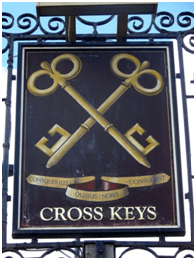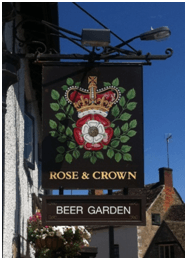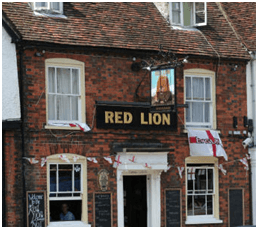Pub Signs and names of Britain
Almost everyone in Britain loves an “Olde Worlde” pub with its oak beams, horse brasses and roaring log fires, which represents the past. In fact, no matter how old the pub itself, the name on the sign outside is probably the most historic thing about the place. The signs depict everything, from battles to inventions, from sporting heroes to royalty. For example, the Black, White, Red and Golden Lions have formed part of the royal coat of arms since the time of the Norman Conquest. The Unicorn was in the Scottish arms, the Red Dragon in the Welsh and the White Horse in the Hanoverian. The Rising Sun was the badge of Edward III.
The idea of the pub sign came to Britain at the time of the Roman invasion. Wine bars ( called ‘Tabernae’) in ancient Rome hung bunches of vine leaves outside as trading signs but when the Romans came to the UK, they could hardly find any vine leaves due to the inhospitable climate. Instead, they hung up bushes to mark out the inns and the names Bush or Bull & Bush still survive as pub names.
The naming of inns and pubs became common by the 12th century. With pub names came pub signs – as the majority of the population could not read or write. In 1393, King Richard VII passed an Act making it compulsory for pubs and inns to have a sign (his own emblem the ‘White Hart’ in London) in order to identify them to the official Ale Taster. Ever since then, inn names and signs have reflected, and followed, British life at that time.
Before King Henry VIII and the Reformation, many had a religious theme, for example, ‘The Crossed Keys’, the emblem of St. Peter. When Henry split with the Catholic Church, names were changed from religious themes to ‘The King’s Head’ or ‘The Rose & Crown’ etc.
The ‘Red Lion’ is probably the most common name for a pub and originates from the time of James I and VI of Scotland who came to the throne in 1603. James ordered that the heraldic red lion of Scotland be displayed on all buildings of importance – including pubs!
Many signs have royal links: for instance, most ‘White Lion’ inns date from the time of Edward IV and the ‘White Boar’ was the emblem of Richard III.
Pubs are also named after famous people in history, for example, The Duke of Wellington and Shakespeare.
In the days of a largely illiterate population, pictorial signs were an essential way of advertising the inn or the type of entertainment on offer inside. Any pub called the Cock Inn or the Cock Pit would once have been a venue for cock fighting . As to other entertainments, the Bear denotes bear baiting, the Dog & Duck hunting and the Bull & Dog bull baiting. Nowadays, the more modern sports are represented by names like the Cricketers’ Arms, the Anglers’ Rest or the Huntsman.
It is rare to take time to consider the sign outside the pub in the rush to get inside but few pubs were named by accident. Almost every name has a story behind it and, together, they illustrate the social history of England. With names enduring for centuries it is possible that the sign above the door is as old as the pleasure of drinking itself.







